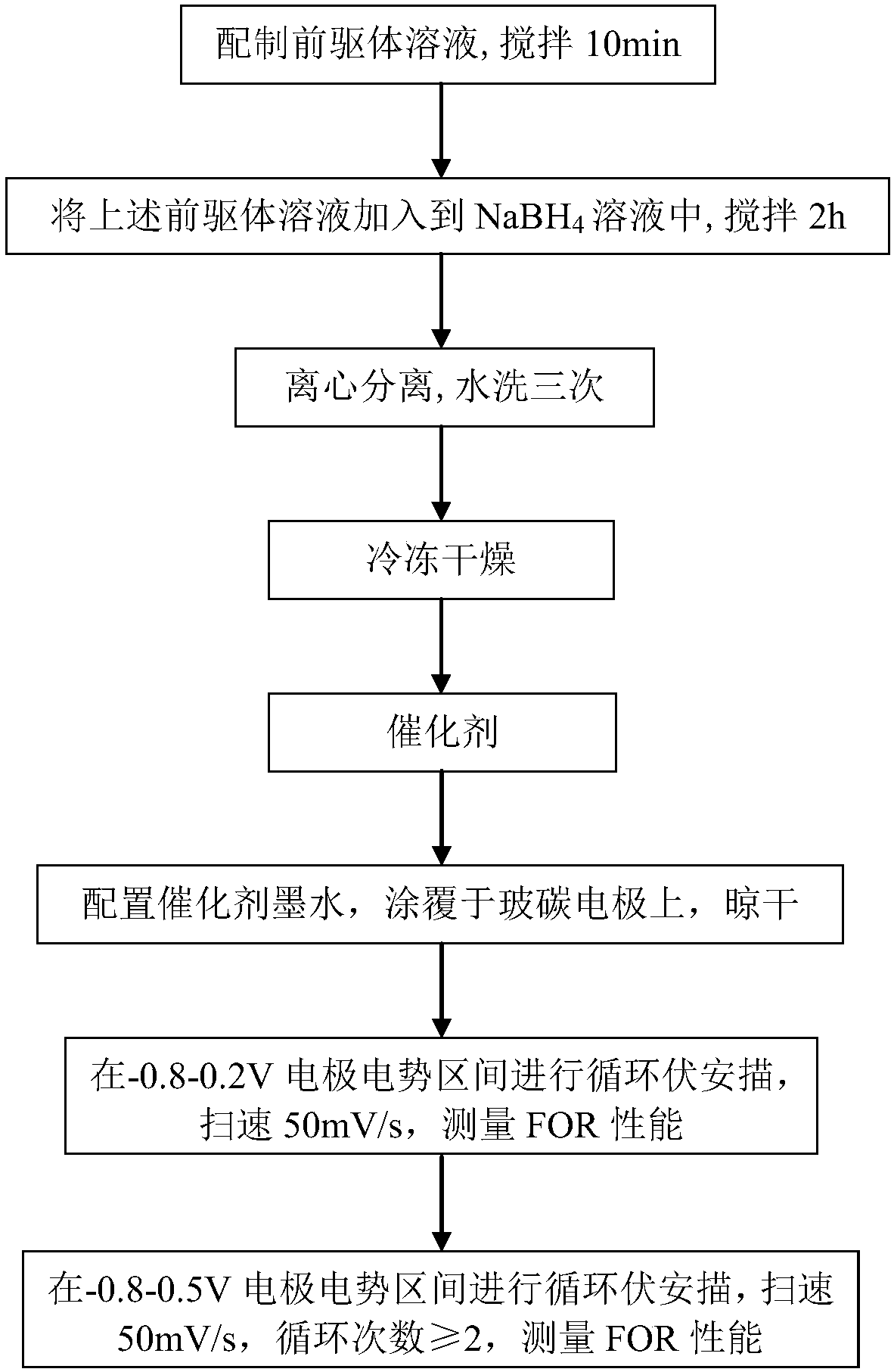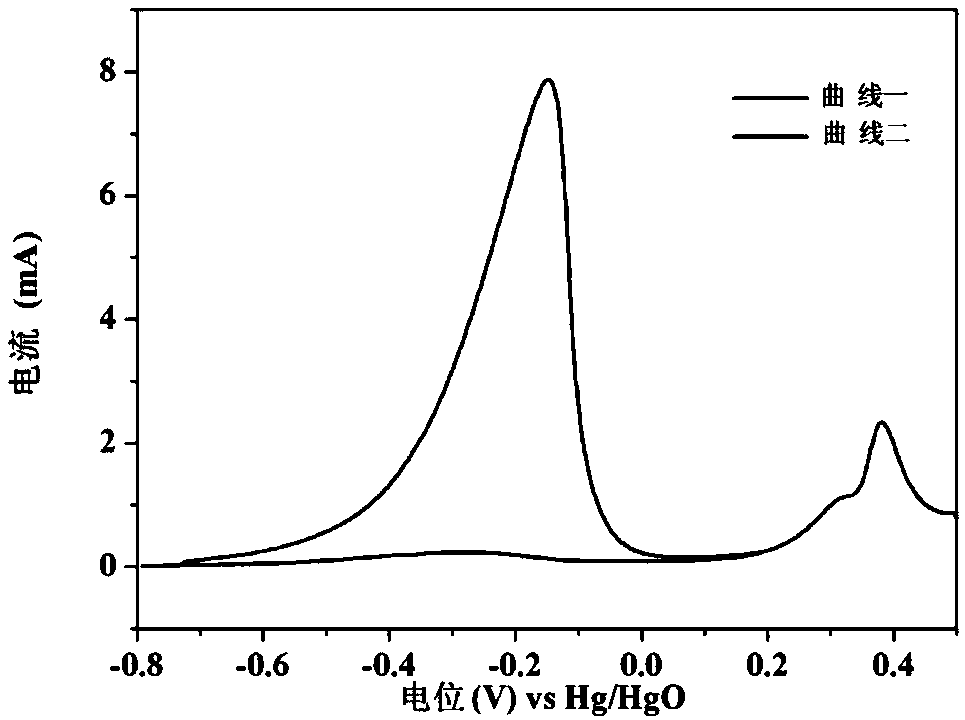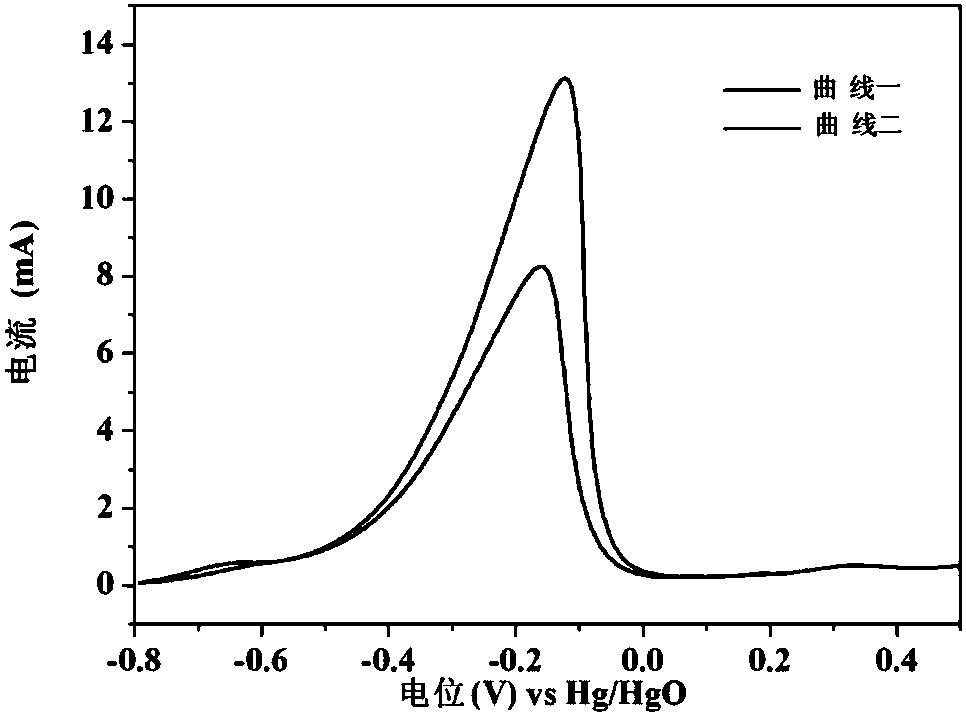AgPd nano-alloy formate oxidation catalyst and treatment method of non-surfactant for improving catalytic activity
A technology of oxidation catalyst and nano-alloy, which is applied in the direction of electrical components, battery electrodes, circuits, etc., can solve the problems of inhibiting catalytic activity and the performance of Pd-based catalysts is not obvious, and achieve the effect of improving catalytic performance and FOR catalytic performance
- Summary
- Abstract
- Description
- Claims
- Application Information
AI Technical Summary
Problems solved by technology
Method used
Image
Examples
example 1
[0043] 1 g of 99% AgNO 3 Dissolved in 58.9mL deionized water to prepare a 0.1mol / L aqueous solution, 1g of 99% Pd(NO 3 ) 2 Dissolved in 43.1mL deionized water to prepare a 0.1mol / L aqueous solution, 0.25g 99% NaBH 4 Dissolve in 66mL of deionized water to prepare a 0.1mol / L aqueous solution. Take the above AgNO 3 Aqueous solution, Pd(NO 3 ) 2 The aqueous solution was mixed and stirred for 10 minutes (volume ratio 3:1) and added dropwise to NaBH 4 In aqueous solution, stir at room temperature for 2h until the reaction is complete. Then the solution was centrifuged (4000rpm, 3min), washed three times with plasma water, freeze-dried for 12h, and ground to obtain Pd 0.34 Ag 0.66 catalyst. Weigh 2mg Pd 0.34 Ag 0.66 The catalyst is dispersed in a mixed solution of deionized water and absolute ethanol, 20 microliters of 5% membrane solution is added dropwise, ultrasonicated for 30 minutes, and then coated on a glassy carbon electrode, and dried at room temperature. In the ...
example 2
[0045] Take the above AgNO 3 Aqueous solution, Pd(NO 3 ) 2 The aqueous solution was mixed and stirred for 10 minutes (volume ratio 1:1) and added dropwise to NaBH 4 In aqueous solution, stir at room temperature for 2h until the reaction is complete. Then the solution was centrifuged (4000rpm, 3min), washed three times with plasma water, freeze-dried for 12h, and ground to obtain Pd 0.5 Ag 0.5 catalyst. Weigh 2mg Pd 0.5 Ag 0.5 The catalyst is dispersed in a mixed solution of deionized water and absolute ethanol, 20 microliters of 5% membrane solution is added dropwise, ultrasonicated for 30 minutes, and then coated on a glassy carbon electrode, and dried at room temperature. In the lower electrode potential interval -0.8-0.2V (relative to the Hg / HgO electrode), a cyclic voltammetry scan was performed at a scan rate of 50mV / s to measure the FOR performance (see image 3 Curve 1). On this basis, the electrode potential range was expanded to -0.8-0.5V (relative to the Hg / ...
example 3
[0047] Take the above AgNO 3 Aqueous solution, Pd(NO 3 ) 2 The aqueous solution was mixed and stirred for 10 minutes (volume ratio 3:1) and added dropwise to NaBH 4 In aqueous solution, stir at room temperature for 2h until the reaction is complete. Then the solution was centrifuged (4000rpm, 3min), washed three times with plasma water, freeze-dried for 12h, and ground to obtain Pd 0.66 Ag 0.34 catalyst. Weigh 2mg Pd 0.66 Ag 0.34 The catalyst is dispersed in a mixed solution of deionized water and absolute ethanol, 20 microliters of 5% membrane solution is added dropwise, ultrasonicated for 30 minutes, and then coated on a glassy carbon electrode, and dried at room temperature. In the lower electrode potential interval -0.8-0.2V (relative to the Hg / HgO electrode), a cyclic voltammetry scan was performed at a scan rate of 50mV / s to measure the FOR performance (see Figure 4 Curve 1). On this basis, the electrode potential range was expanded to -0.8-0.5V (relative to th...
PUM
| Property | Measurement | Unit |
|---|---|---|
| Peak current | aaaaa | aaaaa |
| Electrode area | aaaaa | aaaaa |
Abstract
Description
Claims
Application Information
 Login to View More
Login to View More - R&D
- Intellectual Property
- Life Sciences
- Materials
- Tech Scout
- Unparalleled Data Quality
- Higher Quality Content
- 60% Fewer Hallucinations
Browse by: Latest US Patents, China's latest patents, Technical Efficacy Thesaurus, Application Domain, Technology Topic, Popular Technical Reports.
© 2025 PatSnap. All rights reserved.Legal|Privacy policy|Modern Slavery Act Transparency Statement|Sitemap|About US| Contact US: help@patsnap.com



